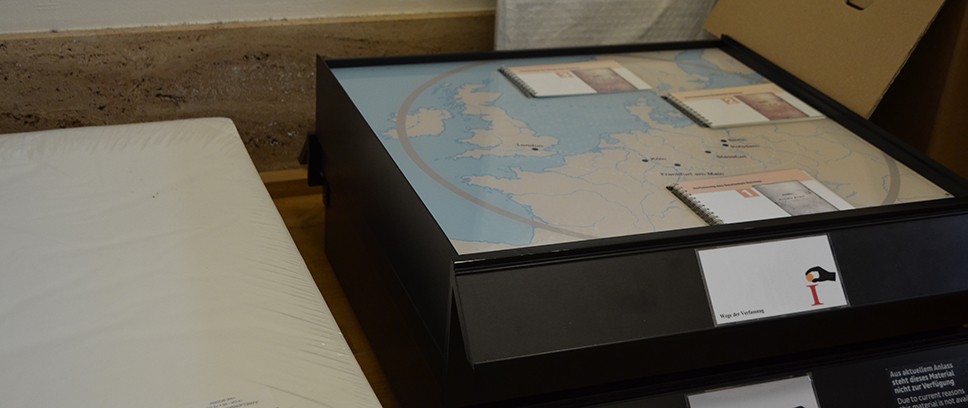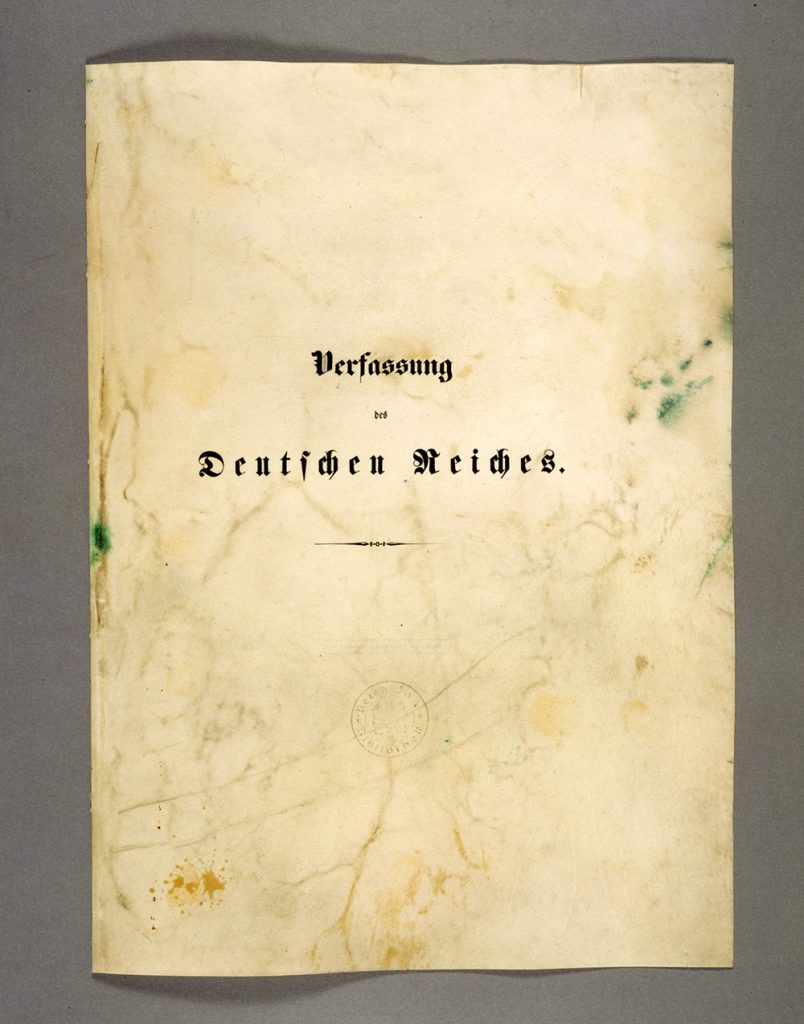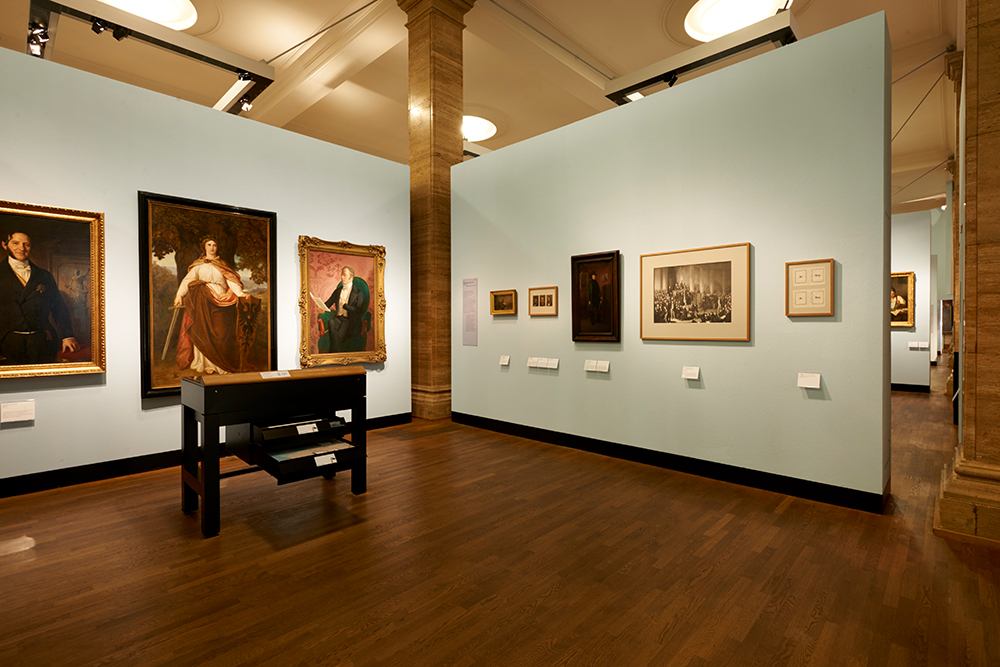
5 Questions for: Stefan Bresky
2 March 2022
The Zeughaus, the Deutsches Historisches Museum’s main building, is currently closed for renovation and the permanent exhibition “German History from the Middle Ages to the Fall of the Berlin Wall” is being carefully dismantled and put into storage. At the same time, the DHM is busy working on plans for a new Permanent Exhibition – a major project affecting all departments across the museum. In our interview series „5 Questions for…“, we give museum curators and staff the chance to talk about their personal memories of the last permanent exhibition and what they are working on now. This time in conversation: Stefan Bresky, Head of Education and Communication at the German Historical Museum.
Mr. Bresky, the permanent exhibition shut in late June 2021. Was there a particular object or section in it that occupies a special place in your memory?
Stefan Bresky: My highlight would be the Constitution of the German Empire of 1849, featuring the actual signatures of the members of the Frankfurt National Assembly and the interactive presentation that we placed alongside it. At first glance, the sheet seems to be an ordinary-looking archival document, but it shows interesting signs of use and wear and tear. This exhibit speaks of the people’s desire for freedom, to shake off the shackles of oppression, and the idea of the natural equality of humankind. However, when the German princes and kings regained power, the document didn’t become a constitutional reality; the revolution of 1848/49 had failed.

The Frankfurt Constitution is a special educational resource because it marks a stepping stone on the path to a modern constitutional state and civil society in Germany. Especially in regard to the section on fundamental rights, which lays out rights to freedom (of expression and of personal liberty, for example) and the right to property. While preparing the last permanent exhibition in 2006, we were faced with the question of how to make this exhibit “speak”. Which narrative angle could we pursue to arouse visitor interest and convey the modern significance of the object? Within the scope of the technical possibilities available to us at the time, we opted for two slide-out displays addressing the history of the document’s impact and textual transmission that could be viewed directly alongside the original.
The first slide-out drawer contained a revolving cylinder that visitors could turn. The cylinder allowed them to compare the 1849 rights to freedom with later passages from the Weimar Constitution, the present “Basic Law” of the Federal Republic of Germany (effectively the constitution in all but name), and the former constitution of the GDR. This documentary slice through history made clear how this exhibit had enduring reverberations in the subsequent constitutional history of Germany, well into the late 20th century.
The second slide-out drawer presented the turbulent history of the document’s textual transmission in the form of a map of Europe. After its composition in Frankfurt, this constitutional document travelled to Cologne, Great Britain, Berlin, and the small town of Staßfurt in Saxony-Anhalt, before being found in 1951 in the Neuer Garten in Potsdam and brought to the Zeughaus in Berlin. Patches of discolouration, water stains, and cockling still bear witness to this object’s adventurous journey down through the ages.

Were you involved in setting up the permanent exhibition in 2006? Was there anything from that time that left a lasting impression on you?
I was hired at the Deutsches Historisches Museum in 2004, to work on making the permanent exhibition accessible as a teaching and learning resource. As a new employee – I started almost two years before the exhibition opening – I saw just how much preparation goes into a large-scale project like that. Many plans had already been set in place by the time I joined. This naturally limited the scale of possible interventions to the exhibition layout and design and the hanging scheme. Many of the learning stations we had envisaged had to be curtailed. That in itself was a sobering realization, but it also showed me that projects at the DHM involve many different people from different departments, and how much meticulous planning and interdepartmental expertise go into preparing exhibitions at the museum.
Will the education programme continue during the closure?
Well, the museum itself isn’t closed; only the permanent exhibition is. We are fortunate in that the Pei Building is still open to our audience, where we hold temporary exhibitions. But other than that, we’ve already developed numerous digital offerings and learning resources over the course of the pandemic. These took the form of live-streamed guided tours of specific periods, so that we could cover German history from the Middle Ages to the present moment, as well as offer various themed tours that took a closer look at the history of women’s rights or gender, for example. These digital presentations are now available for individual use or for groups and school classes and feature prepared sequences on select objects and former exhibition chapters. This digital resource is embedded in a live talk, so viewers can put questions to the speakers live on the day.
In March, the IDA learning portal went live via the DHM website. This interactive digital offering is being launched with content on the Middle Ages and the French Revolution, with the intention of adding further pages over time. The respective pages feature short introductory texts on the period, events, and major historical figures, combined with interactive elements to enhance the user experience. These include, for example, selected 360° panoramas of the old permanent exhibition.
Can you give us an idea of the scale of the previous permanent exhibition? How many hands-on interactive stations did it contain?
There were 35 interactive displays that complemented the collection presentation, which was spread over 7000 square metres of floor space. On top of these in-person interactive displays, we also had digital offerings and audio footage. The exhibition featured more than 500 audio guide points aimed at adults, children, and families. We also catered to the growing demand from tourists, with seven foreign-language versions of the audio guide available. The Chinese version saw the biggest spike in demand in recent years.
Is there anything that your department would like to take up or pursue again in the new permanent exhibition?
An important first step was the interdepartmental development of the master plan for the new permanent exhibition. As a museum educator, I am especially pleased that in future the Zeughaus will have its own exhibition area for children and families.
A second important step is that the curatorial planning will also take object-related learning into account. Visitors come to our “bricks-and-mortar” museum because of the visual experience of the exhibits. We want to help them explore historical objects. Parallel to the advancing digitalization, classic hands-on interactive stations for multisensory and inclusive learning will remain an important component in the palette of educational resources. Future exhibition visitors will have access to a stimulating mix of digital and analogue offerings that convey history in the museum in a multisensory way.